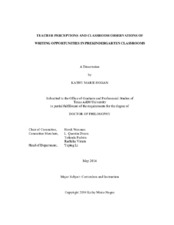| dc.description.abstract | This multiple-article dissertation examined secondary data collected by an
educational service center in a large area of southeast Texas to analyze the similarities
and differences in writing practices of prekindergarten teachers. The aim of this study
was to determine the direction of future professional development sessions and coaching
to support the implementation of writing in prekindergarten. The first study
investigated teacher perceptions of writing practices and writing usage by type and
frequency as collected through descriptive statistics and analysis from a self-report
study. The second study examined the educational use of writing and writing artifacts
through observational research of three interacting components in prekindergarten
classrooms: the teacher, five students, and the overall classroom. Four different
educational environments were investigated: rural, suburban, urban, and private schools.
Authentic classroom behaviors and differences between monolingual and English
Language Learners (ELLs) were investigated in relation to their use of writing.
The findings from both studies revealed great variability from frequent to
infrequent classroom use of writing. The results from the first study revealed that a few
classrooms used writing to a great extent, especially in dramatic play areas, such as a
doctor’s office or restaurant to enhance play. In other classrooms, teachers reported that
children write their names on a regular basis or draw pictures in journals, but otherwise
do not use writing. In many classrooms, the Morning Message or lists were developed
as a teacher-child collaborative effort during shared writing, but often these activities did
not take place. The second study revealed how writing usage in the classroom also varied, from procedural skills, such as tracing and copying letters or words, to conceptual use, creating stories using drawings and invented spelling, to the implementation of a fully developed Writer’s Workshop in prekindergarten. Results suggest that prekindergarten teachers are generally unsure how to use writing in the classroom, how often to use it, and how appropriate its use is with young children. The implications of these studies provide useful information on current practices and suggest that professional development and coaching may enhance teaching practices by demonstrating ways to increase access to writing opportunities. | en |


